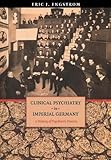Clinical Psychiatry in Imperial Germany : A History of Psychiatric Practice / Eric J. Engstrom.
Material type: TextSeries: Cornell Studies in the History of PsychiatryPublisher: Ithaca, NY : Cornell University Press, [2018]Copyright date: ©2004Description: 1 online resource (320 p.)Content type:
TextSeries: Cornell Studies in the History of PsychiatryPublisher: Ithaca, NY : Cornell University Press, [2018]Copyright date: ©2004Description: 1 online resource (320 p.)Content type: - 9781501723940
- 616.89/00943/09034 22
- RC450.G4 E54 2003eb
- online - DeGruyter
| Item type | Current library | Call number | URL | Status | Notes | Barcode | |
|---|---|---|---|---|---|---|---|
 eBook
eBook
|
Biblioteca "Angelicum" Pont. Univ. S.Tommaso d'Aquino Nuvola online | online - DeGruyter (Browse shelf(Opens below)) | Online access | Not for loan (Accesso limitato) | Accesso per gli utenti autorizzati / Access for authorized users | (dgr)9781501723940 |
Browsing Biblioteca "Angelicum" Pont. Univ. S.Tommaso d'Aquino shelves, Shelving location: Nuvola online Close shelf browser (Hides shelf browser)

|

|

|

|

|

|

|
||
| online - DeGruyter Rivals beyond Trade : America versus Japan in Global Competition / | online - DeGruyter Medieval Cruelty : Changing Perceptions, Late Antiquity to the Early Modern Period / | online - DeGruyter Self and Story in Russian History / | online - DeGruyter Clinical Psychiatry in Imperial Germany : A History of Psychiatric Practice / | online - DeGruyter Gendering the Master Narrative : Women and Power in the Middle Ages / | online - DeGruyter Nationalism and Historical Loss in Renaissance England : Foxe, Dee, Spenser, Milton / | online - DeGruyter Ethnic Politics / |
Frontmatter -- Contents -- Acknowledgments -- Abbreviations -- CHAPTER 1. Introduction -- CHAPTER 2: The Topography of Mid-NineteenthCentury Psychiatry -- CHAPTER 3. Wilhelm Griesinger's Reform Program: The Professional Politics of the Urban Asylum -- CHAPTER 4. Laboratory Science: Psychiatric Research in the 1870s and 1880s -- CHAPTER 5. Bedside Science: Clinical Research in Heidelberg -- CHAPTER 6. Clinical Teaching -- CHAPTER 7. Social Prophylaxis: Psychiatric Polyclinics -- CHAPTER 8. Conclusion: Clinical Psychiatry and the Politics of Professional Practice -- Bibliography -- Index
restricted access online access with authorization star
http://purl.org/coar/access_right/c_16ec
The psychiatric profession in Germany changed radically from the mid-nineteenth century to the beginning of World War I. In a book that demonstrates his extensive archival knowledge and an impressive command of the primary literature, Eric J. Engstrom investigates the history of university psychiatric clinics in Imperial Germany from 1867 to 1914, emphasizing the clinical practices and professional debates surrounding the development of these institutions and their impact on the course of German psychiatry.The rise of university psychiatric clinics reflects, Engstrom tells us, a shift not only in asylum culture, but also in the ways in which social, political, and economic issues deeply influenced the practice of psychiatry. Equally convincing is Engstrom's argument that psychiatrists were responding to and working to shape the rapidly changing perceptions of madness in Imperial Germany. In a series of case studies, the book focuses on a number of important clinical spaces such as the laboratory, the ward, the lecture hall, and the polyclinic. Engstrom argues that within these spaces clinics developed their own disciplinary economies and that their emergence was inseparably intertwined with jurisdictional contests between competing scientific, administrative, didactic, and sociopolitical agendas.
Mode of access: Internet via World Wide Web.
In English.
Description based on online resource; title from PDF title page (publisher's Web site, viewed 26. Apr 2024)


